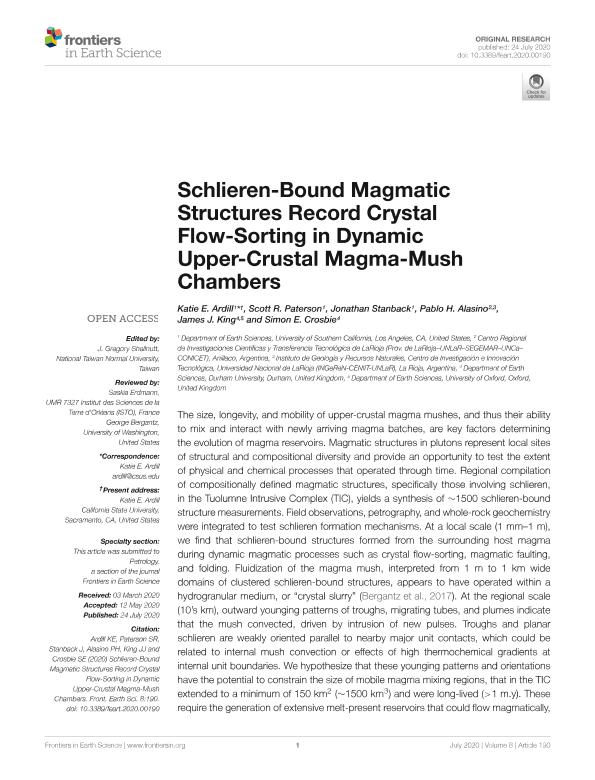Mostrar el registro sencillo del ítem
dc.contributor.author
Ardill, Katie E.
dc.contributor.author
Paterson, Scott Robert

dc.contributor.author
Stanback, Jonathan
dc.contributor.author
Alasino, Pablo Horacio

dc.contributor.author
King, James J.
dc.contributor.author
Crosbie, Simon E.
dc.date.available
2021-10-25T18:44:45Z
dc.date.issued
2020-07-24
dc.identifier.citation
Ardill, Katie E.; Paterson, Scott Robert; Stanback, Jonathan; Alasino, Pablo Horacio; King, James J.; et al.; Schlieren bound magmatic structures record crystal flow sorting in dynamic upper crustal magma mush chambers; Frontiers Media; Frontiers in Earth Science; 8; 190; 24-7-2020; 1-35
dc.identifier.issn
2296-6463
dc.identifier.uri
http://hdl.handle.net/11336/144987
dc.description.abstract
The size, longevity, and mobility of upper-crustal magma mushes, and thus their ability to mix and interact with newly arriving magma batches, are key factors determining the evolution of magma reservoirs. Magmatic structures in plutons represent local sites of structural and compositional diversity and provide an opportunity to test the extent of physical and chemical processes that operated through time. Regional compilation of compositionally defined magmatic structures, specifically those involving schlieren, in the Tuolumne Intrusive Complex (TIC), yields a synthesis of ∼1500 schlieren-bound structure measurements. Field observations, petrography, and whole-rock geochemistry were integrated to test schlieren formation mechanisms. At a local scale (1 mm–1 m), we find that schlieren-bound structures formed from the surrounding host magma during dynamic magmatic processes such as crystal flow-sorting, magmatic faulting, and folding. Fluidization of the magma mush, interpreted from 1 m to 1 km wide domains of clustered schlieren-bound structures, appears to have operated within a hydrogranular medium, or “crystal slurry” (Bergantz et al., 2017). At the regional scale (10’s km), outward younging patterns of troughs, migrating tubes, and plumes indicate that the mush convected, driven by intrusion of new pulses. Troughs and planar schlieren are weakly oriented parallel to nearby major unit contacts, which could be related to internal mush convection or effects of high thermochemical gradients at internal unit boundaries. We hypothesize that these younging patterns and orientations have the potential to constrain the size of mobile magma mixing regions, that in the TIC extended to a minimum of 150 km2 (∼1500 km3) and were long-lived (>1 m.y). These require the generation of extensive melt-present reservoirs that could flow magmatically, formed from the amalgamation of intruding magma pulses, and precludes dike, sill, or laccolith emplacement models. We conclude that schlieren-bound structures are faithful recorders of the multi-scale, hypersolidus evolution of upper-crustal magma bodies, and represent useful tools for studying plutonic systems.
dc.format
application/pdf
dc.language.iso
eng
dc.publisher
Frontiers Media

dc.rights
info:eu-repo/semantics/openAccess
dc.rights.uri
https://creativecommons.org/licenses/by-nc-sa/2.5/ar/
dc.subject
CRYSTAL MUSH
dc.subject
FLOW SORTING
dc.subject
MAGMATIC FABRIC
dc.subject
MAGMATIC STRUCTURES
dc.subject
SCHLIEREN
dc.subject
SIERRA NEVADA
dc.subject
TUOLUMNE INTRUSIVE COMPLEX
dc.subject.classification
Geología

dc.subject.classification
Ciencias de la Tierra y relacionadas con el Medio Ambiente

dc.subject.classification
CIENCIAS NATURALES Y EXACTAS

dc.title
Schlieren bound magmatic structures record crystal flow sorting in dynamic upper crustal magma mush chambers
dc.type
info:eu-repo/semantics/article
dc.type
info:ar-repo/semantics/artículo
dc.type
info:eu-repo/semantics/publishedVersion
dc.date.updated
2021-09-07T20:00:15Z
dc.journal.volume
8
dc.journal.number
190
dc.journal.pagination
1-35
dc.journal.pais
Suiza

dc.description.fil
Fil: Ardill, Katie E.. University of Southern California; Estados Unidos
dc.description.fil
Fil: Paterson, Scott Robert. University of Southern California; Estados Unidos
dc.description.fil
Fil: Stanback, Jonathan. University of Southern California; Estados Unidos
dc.description.fil
Fil: Alasino, Pablo Horacio. Consejo Nacional de Investigaciones Científicas y Técnicas. Centro Regional de Investigaciones Científicas y Transferencia Tecnológica de La Rioja. - Universidad Nacional de La Rioja. Centro Regional de Investigaciones Científicas y Transferencia Tecnológica de La Rioja. - Universidad Nacional de Catamarca. Centro Regional de Investigaciones Científicas y Transferencia Tecnológica de La Rioja. - Secretaría de Industria y Minería. Servicio Geológico Minero Argentino. Centro Regional de Investigaciones Científicas y Transferencia Tecnológica de La Rioja. - Provincia de La Rioja. Centro Regional de Investigaciones Científicas y Transferencia Tecnológica de La Rioja; Argentina. Universidad Nacional de La Rioja; Argentina
dc.description.fil
Fil: King, James J.. University of Oxford; Reino Unido. University of Durham; Reino Unido
dc.description.fil
Fil: Crosbie, Simon E.. University of Durham; Reino Unido
dc.journal.title
Frontiers in Earth Science
dc.relation.alternativeid
info:eu-repo/semantics/altIdentifier/doi/http://dx.doi.org/10.3389/feart.2020.00190
dc.relation.alternativeid
info:eu-repo/semantics/altIdentifier/url/https://www.frontiersin.org/articles/10.3389/feart.2020.00190/full
Archivos asociados
